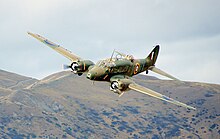
Summary
783 Naval Air Squadron (783 NAS) was a Naval Air Squadron of the Royal Navy's Fleet Air Arm which last disbanded in November 1949. 783 Naval Air Squadron was formed as an ASV Training Squadron (air-to-surface vessel radar) at HMS Condor, RNAS Arbroath, Scotland, in January 1941. It operated a number of ‘flying classroom’ aircraft alongside other types. It operated in conjunction with the Naval Air Signals School (NASS) from March 1943. The squadron moved to HMS Daedalus, RNAS Lee-on-Solent, England, when the NASS moved south, also supporting the Flag Officer, Air, Home Communications Officer and from July 1948,it was part of the 51st Miscellaneous Air Group.
| 783 Naval Air Squadron | |
|---|---|
| Active | 9 January 1941 - 18 November 1949[1] |
| Country | |
| Branch | |
| Type | Fleet Air Arm Second Line Squadron |
| Role | ASV Training Squadron |
| Size | Squadron |
| Part of | Fleet Air Arm |
| Garrison/HQ | RNAS Arbroath (HMS Condor) RNAS Lee-on-Solent (HMS Daedalus) |
| Insignia | |
| Identification Markings | Individual numbers, then A0A+ & A6A+ (from 1941) 601-608 (Anson from 1947) 323-335 (Barracuda from 1947)[2][3] |
| Tail Codes | LP (from 1947)[3] |

History of 783 NAS edit
ASV Training Squadron (1941 - 1949) edit
783 Naval Air Squadron formed on 9 January 1941 at RNAS Arbroath (HMS Condor) as the Air-to-Surface Vessel radar (ASV) training squadron.[2] Essentially the squadron formed from an existing ASV training Flight which was based at HMS Condor.[3] It was quipped with Fairey Swordfish, a biplane torpedo bomber, Fairey Albacore, also a biplane torpedo bomber, and Supermarine Walrus, an amphibious maritime patrol aircraft. It also used a de Havilland DH.86 Express which was fitted out as an air-to-surface vessel radar flying classroom, although the main flying classroom operated was the Avro Anson, a multirole aircraft, used primarily as a trainer aircraft. The de Havilland Express was damaged by ‘friendly fire' from a Royal Navy minesweeper and was replaced with a Vickers Wellington, a long range medium bomber[2] and over time more of these aircraft were received, equipped with ASV radar.[3]
From March 1943, 783 Naval Air Squadron operated in conjunction with the Naval Air Signal School, at RNAS Arbroath. It received Fairey Firefly, a carrier-borne fighter and anti-submarine aircraft, Fairey Barracuda, a carrier-borne torpedo and dive bomber, and Grumman Avenger, an American torpedo bomber.[2] In May 1947 the squadron moved south relocating to RNAS Lee-on-Solent (HMS Daedalus), in Hampshire, with the Naval Air Signal School now based at Seafield Park, Hampshire which was situated next to the airbase. At then at the end of the year it temporarily operated a number of Fairey Barracuda TR.5, before receiving new Avro Anson aircraft. The squadron also operated an Avro Anson for use by the Flag Officer, Air, Home Communications Officer. The following year, in July 1948, the squadron made up part of the 51st Miscellancous Air Group and then in 1949 it ran a radio refresher course for Observers and Aircrew. 783 Naval Air Squadron disbanded on 18 November 1949.[3]
Aircraft operated edit
The squadron operated a number of different aircraft types, including:[4]
- Fairey Swordfish II torpedo bomber (January 1941 - July 1945)
- Supermarine Walrus maritime patrol aircraft (January 1941 - January 1944)
- de Havilland Express passenger transport aircraft (August 1941 - July 1942)
- Avro Anson I multirole aircraft (January 1942 - November 1949)
- Fairey Albacore torpedo bomber (December 1942 - February 1943)
- Vickers Wellington I medium bomber (February 1944 - June 1945)
- Fairey Firefly I/FR.I fighter and reconnaissance aircraft (September 1944 - December 1946)
- Fairey Barracuda II torpedo and dive bomber (October 1944 - December 1946)
- Grumman Avenger torpedo bomber (December 1944 - July 1946)
- Fairey Barracuda TR.5 torpedo and dive bomber (November 1947 - October 1948)
edit
783 Naval Air Squadron operated from a couple of naval air stations of the Royal Navy, in the United Kingdom:[4]
- Royal Naval Air Station ARBROATH (HMS Condor) (9 January 1941 - 15 May 1947)
- Royal Naval Air Station LEE-ON-SOLENT (HMS Daedalus) (15 May 1947 - 18 November 1949)
- disbanded - (18 November 1949)
Commanding Officers edit
List of commanding officers of 783 Naval Air Squadron with day, month and year of appointment:[2][4]
- Lieutenant Commander(A) J.M. Waddell, RNVR, from 9 January 1941
- Lieutenant Commander(A) J.M. Kene-Miller, RNVR, from 7 November 1941
- Lieutenant Commander(A) D.M. Brown, RNVR, from 15 June 1942
- Lieutenant Commander(A) R.P. Mason, RNVR, from 29 December 1942
- Lieutenant Commander(A) T.B. Horsley, RNVR, from 30 August 1944
- Lieutenant(A) W.L.M. Daubney, RNVR, from 10 November 1945
- Lieutenant(A) E.H.G. Child, RNVR, from 10 December 1945
- Lieutenant M.H. Sandes, RCNR, from 1 July 1946
- Lieutenant Commander A.M. Tuke, DSC, RN, from 1 December 1946
- Lieutenant Commander K.C. Winstanley, RN, from 1 December 1947 (KIFA 30 May 1948)
- Lieutenant G.H. Colles, RN, from 31 May 1948
- Lieutenant P.H. Parsons, MBE, RN, from 24 September 1949
- disbanded - 18 November 1949
References edit
Citations edit
- ^ Sturtivant, Ballance 1994, p. 105.
- ^ a b c d e Wragg 2019, p. 135.
- ^ a b c d e Ballance, Howard & Sturtivant 2016, p. 86.
- ^ a b c Ballance, Howard & Sturtivant 2016, p. 87.
Bibliography edit
- Ballance, Theo; Howard, Lee; Sturtivant, Ray (2016). The Squadrons and Units of the Fleet Air Arm. Air Britain Historians Limited. ISBN 978-0-85130-489-2.
- Sturtivant, R; Ballance, T (1994). The Squadrons of The Fleet Air Arm. Tonbridge, Kent, UK: Air-Britain (Historians) Ltd. ISBN 0-85130-223-8.
- Wragg, David (2019). The Fleet Air Arm Handbook 1939-1945. Cheltenham, Gloucestershire, UK: The History Press. ISBN 978-0-7509-9303-6.


